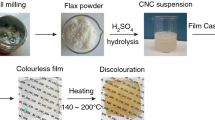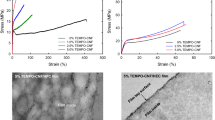Abstract
The brittleness of ethyl cellulose (EC) film limited its full applications, and the addition of plasticizers is one of the most common methods to reduce its brittleness. However, the mechanical properties are normally dropped with the addition of plasticizers. Herein, cellulose nanocrystal (CNC) was chosen as a reinforcing agent to improve its mechanical properties. CNC was firstly extracted from the tobacco-stem and then modified by epoxidized soybean oil (ESO) via ring-opening grafting to obtain epoxidized soybean oil grafting CNC (ECNC). The grafting effect was evaluated by FTIR and XPS. After that, the films of ECNC/EC nanocomposites were prepared by the solution-casting method, and their mechanical, thermal and optical properties and fracture morphology were investigated. The results showed that at 4 phr loading of ECNC, the tensile strength of the nanocomposite film was up to 43.7 Mpa (about twice as much as that of the EC film plasticized by ESO), and the elongation at break was not influenced. Moreover, a higher thermal decomposition temperature was achieved for the ECNC/EC films. Besides, owing to the good dispersion, ECNC had no significant impact on the transparency, and the films presented high light transmittance in the visible light region.
Graphic abstract











Similar content being viewed by others
References
Abraham E, Kam D, Nevo Y, Slattegard R, Rivkin A, Lapidot S, Shoseyov O (2016a) Highly modified cellulose nanocrystals and formation of epoxy-nanocrystalline cellulose (CNC) nanocomposites. ACS Appl Mater Interfaces 8:28086–28095
Abraham E, Nevo Y, Slattegard R, Attias N, Sharon S, Lapidot S, Shoseyov O (2016b) highly hydrophobic thermally stable liquid crystalline cellulosic nanomaterials. ACS Sustain Chem Eng 4:1338–1346
Arca H, Mosquera-Giraldo L, Bi V, Xu D, Taylor LS, Edgar K (2018) Pharmaceutical applications of cellulose ethers and cellulose ether esters. Biomacromolecules 19:2351–2376
Boujemaoui A, Mongkhontreerat S, Malmström E, Carlmark A (2015) Preparation and characterization of functionalized cellulose nanocrystals. Carbohydr Polym 115:457–464
Bruno L, Kasapis S, Heng PWS (2012) Effect of hydration on the structure of non aqueous ethyl cellulose/propylene glycol dicaprylate gels. Int J Biol Macromol 50:385–392
Cai J et al (2016) Well-aligned cellulose nanofiber-reinforced polyvinyl alcohol composite film: mechanical and optical properties. Carbohydr Polym 140:238–245
Chi K, Catchmark JM (2017) Enhanced dispersion and interface compatibilization of crystalline nanocellulose in polylactide by surfactant adsorption. Cellulose 24:4845–4860
Davidovich-Pinhas M, Barbut S, Marangoni AG (2014) Physical structure and thermal behavior of ethylcellulose. Cellulose 21:3243–3255
Davidovich-Pinhas M, Barbut S, Marangoni AG (2015) The gelation of oil using ethyl cellulose. Carbohydr Polym 117:869–878
de Brabander C, van den Mooter G, Vervaet C, Remon JP (2002) Characterization of ibuprofen as a nontraditional plasticizer of ethyl cellulose. J Pharm Sci 91:1678–1685
Dhar P, Kumar A, Katiyar V (2015) Fabrication of cellulose nanocrystal supported stable Fe(0) nanoparticles: a sustainable catalyst for dye reduction, organic conversion and chemo–magnetic propulsion. Cellulose 22:3755–3771
Djerafi R, Masmoudi Y, Crampon C, Meniai A, Badens E (2015) Supercritical anti-solvent precipitation of ethyl cellulose. J Supercrit Fluids 105:92–98
Duan B, Huang Y, Lu A, Zhang L (2018) Recent advances in chitin based materials constructed via physical methods. Prog Polym Sci 82:1–33
Eichhorn SJ et al (2010) Review: current international research into cellulose nanofibres and nanocomposites. J Mater Sci 45:1–33
El Achaby M, El Miri N, Hannache H, Gmouh S, Trabadelo V, Aboulkas A, Ben Youcef H (2018) Cellulose nanocrystals from Miscanthus fibers: insights into rheological, physico-chemical properties and polymer reinforcing ability. Cellulose 25:6603–6619
Gagandeep GT, Malik B, Rath G, Goyal AK (2014) Development and characterization of nano-fiber patch for the treatment of glaucoma. Eur J Pharm Sci 53:10–16
Gan L, Liao J, Lin N, Hu C, Wang H, Huang J (2017) Focus on gradientwise control of the surface acetylation of cellulose nanocrystals to optimize mechanical reinforcement for hydrophobic polyester-based nanocomposites. ACS Omega 2:4725–4736
Gao T, Li Y-Y, Bao R-Y, Liu Z-Y, Xie B-H, Yang M-B, Yang W (2017) Tailoring co-continuous like morphology in blends with highly asymmetric composition by MWCNTs: towards biodegradable high-performance electrical conductive poly(l-lactide)/poly(3-hydroxybutyrate-co-4-hydroxybutyrate) blends. Compos Sci Technol 152:111–119
Garcia-Valdez O, Champagne P, Cunningham MF (2018) Graft modification of natural polysaccharides via reversible deactivation radical polymerization. Prog Polym Sci 76:151–173
Iqbal H, Kyazze G, Tron T, Keshavarz T (2014) “One-pot” synthesis and characterisation of novel P (3HB)–ethyl cellulose based graft composites through lipase catalysed esterification. Polym Chem 5:7004–7012
Kang H, Liu W, He B, Shen D, Ma L, Huang Y (2006) Synthesis of amphiphilic ethyl cellulose grafting poly (acrylic acid) copolymers and their self-assembly morphologies in water. Polymer 47:7927–7934
Kang H, Liu R, Yong H (2013) Cellulose derivatives and graft copolymers as blocks for functional materials. Polym Int 62:338–344
Kargarzadeh H et al (2018) Recent developments in nanocellulose-based biodegradable polymers, thermoplastic polymers, and porous nanocomposites. Prog Polym Sci 87:197–227
Kasiri N, Fathi M (2018) Entrapment of peppermint oil using cellulose nanocrystals. Cellulose 25:319–329
Khanjanzadeh H, Behrooz R, Bahramifar N, Gindl-Altmutter W, Bacher M, Edler M, Griesser T (2018) Surface chemical functionalization of cellulose nanocrystals by 3-aminopropyltriethoxysilane. Int J Biol Macromol 106:1288–1296
Lee A, Choi S-S, Song SJ, Baek KY, Hwang S (2014) Cationically photopolymerizable epoxy-functionalized thermoplastic polysilsesquioxanes: synthesis and properties. RSC Adv 4:56532–56538
Li X, Jiang F, Ni X, Yan W, Fang Y, Corke H, Xiao M (2015) Preparation and characterization of konjac glucomannan and ethyl cellulose blend films. Food Hydrocoll 44:229–236
Ling Z et al (2019) Effects of ball milling on the structure of cotton cellulose. Cellulose 26:305–328
Liu W et al (2019a) Preparation and characterization of reinforced starch-based composites with compatibilizer by simple extrusion. Carbohydr Polym 223:115122
Liu W et al (2019b) Effects of graft architecture on cellulose-based ordered porous film prepared by breath figures. Cellulose 26:6201–6213
Liu W et al (2020) Tailoring ordered microporous structure of cellulose-based membranes through molecular hydrophobicity design. Carbohydr Polym 229:115425
Mathew AP, Oksman K, Karim Z, Liu P, Khan SA, Naseri N (2014) Process scale up and characterization of wood cellulose nanocrystals hydrolysed using bioethanol pilot plant. Ind Crops Prod 58:212–219
Mohamed MA et al (2017) Physicochemical characterization of cellulose nanocrystal and nanoporous self-assembled CNC membrane derived from Ceiba pentandra. Carbohydr Polym 157:1892–1902
Olejar KJ, Ray S, Ricci A, Kilmartin PA (2014) Superior antioxidant polymer films created through the incorporation of grape tannins in ethyl cellulose. Cellulose 21:4545–4556
Orasugh JT et al (2018a) Jute cellulose nano-fibrils/hydroxypropylmethylcellulose nanocomposite: a novel material with potential for application in packaging and transdermal drug delivery system. Ind Crops Prod 112:633–643
Orasugh JT et al (2018b) Synthesis of methylcellulose/cellulose nano-crystals nanocomposites: material properties and study of sustained release of ketorolac tromethamine. Carbohydr Polym 188:168–180
Pajkert R, Kolomeitsev AA, Milewska M, Röschenthaler G-V, Koroniak H (2008) TiCl4 and Grignard reagent-promoted ring-opening reactions of various epoxides: synthesis of γ-hydroxy-α, α-difluoromethylenephosphonates. Tetrahedron Lett 49:6046–6049
Qian S, Zhang H, Yao W, Sheng K (2018) Effects of bamboo cellulose nanowhisker content on the morphology, crystallization, mechanical, and thermal properties of PLA matrix biocomposites. Compos Part B Eng 133:203–209
Raquez JM, Murena Y, Goffin AL, Habibi Y, Ruelle B, DeBuyl F, Dubois P (2012) Surface-modification of cellulose nanowhiskers and their use as nanoreinforcers into polylactide: a sustainably-integrated approach. Compos Sci Technol 72:544–549
Segal L, Creely J, Martin AEJ, Conrad C (1959) An empirical method for estimating the degree of crystallinity of native cellulose using the X-ray diffractometer. Text Res J 29:786–794
Spinella S et al (2015) Polylactide/cellulose nanocrystal nanocomposites: efficient routes for nanofiber modification and effects of nanofiber chemistry on PLA reinforcement. Polymer 65:9–17
Sun Q, Li G, Dai L, Ji N, Xiong L (2014) Green preparation and characterisation of waxy maize starch nanoparticles through enzymolysis and recrystallisation. Food Chem 162:223–228
Tarvainen M et al (2003) Enhanced film-forming properties for ethyl cellulose and starch acetate using n-alkenyl succinic anhydrides as novel plasticizers. Eur J Pharm Sci 19:363–371
Volkova GI, Anufriev RV, Yudina NV (2016) Effect of ultrasonic treatment on the composition and properties of waxy high-resin oil. Pet Chem 56:683–689
Wang S, Lu A, Zhang L (2016) Recent advances in regenerated cellulose materials. Prog Polym Sci 53:169–206
Wu K, Zhu Q, Qian H, Xiao M, Corke H, Nishinari K, Jiang F (2018) Controllable hydrophilicity–hydrophobicity and related properties of konjac glucomannan and ethyl cellulose composite films. Food Hydrocoll 79:301–309
Yang D et al (2014) “Green” films from renewable resources: properties of epoxidized soybean oil plasticized ethyl cellulose films. Carbohydr Polym 103:198–206
Yang Y, Wang H, Li H, Zhimin O, Yang GS (2018) 3D printed tablets with internal scaffold structure using ethyl cellulose to achieve sustained ibuprofen release. Eur J Pharm Sci 115:11–18
Yin Y, Tian X, Jiang X, Wang H, Gao W (2016) Modification of cellulose nanocrystal via SI-ATRP of styrene and the mechanism of its reinforcement of polymethylmethacrylate. Carbohydr Polym 142:206–212
Yuan B, Sun H, Wang T, Xu Y, Li P, Kong Y, Niu QJ (2016) Propylene/propane permeation properties of ethyl cellulose (EC) mixed matrix membranes fabricated by incorporation of nanoporous graphene nanosheets. Scientific Reports 6:28509
Yue L et al (2018) Surface-modified cellulose nanocrystals for biobased epoxy nanocomposites. Polymer 134:155–162
Zhu J, Dong X-T, Wang X-L, Wang Y-Z (2010) Preparation and properties of a novel biodegradable ethyl cellulose grafting copolymer with poly (p-dioxanone) side-chains. Carbohydr Polym 80:350–359
Acknowledgments
The work was supported by Natural Science Foundation of Hunan Province of China (No. 2018JJ2088), Scientific Research Foundation of Hunan Provincial Education Department of China (No. 15K034) and Postgraduate Research and Innovation Project of Hunan Province of China (Nos. CX20190839 and CX2018B735).
Author information
Authors and Affiliations
Corresponding author
Ethics declarations
Conflict of interest
The authors declare that they have no competing interests.
Additional information
Publisher's Note
Springer Nature remains neutral with regard to jurisdictional claims in published maps and institutional affiliations.
Rights and permissions
About this article
Cite this article
Shi, J., Liu, W., Jiang, X. et al. Preparation of cellulose nanocrystal from tobacco-stem and its application in ethyl cellulose film as a reinforcing agent. Cellulose 27, 1393–1406 (2020). https://doi.org/10.1007/s10570-019-02904-0
Received:
Accepted:
Published:
Issue Date:
DOI: https://doi.org/10.1007/s10570-019-02904-0




